The main dish of today’s bento is Shumai. My Shumai Bento is a colourful bento – the rice is covered with Japanese scrambled eggs and green peas, and decorated with flower-shaped carrots. The pickled red cabbage adds an extra colour to the already colourful bento!
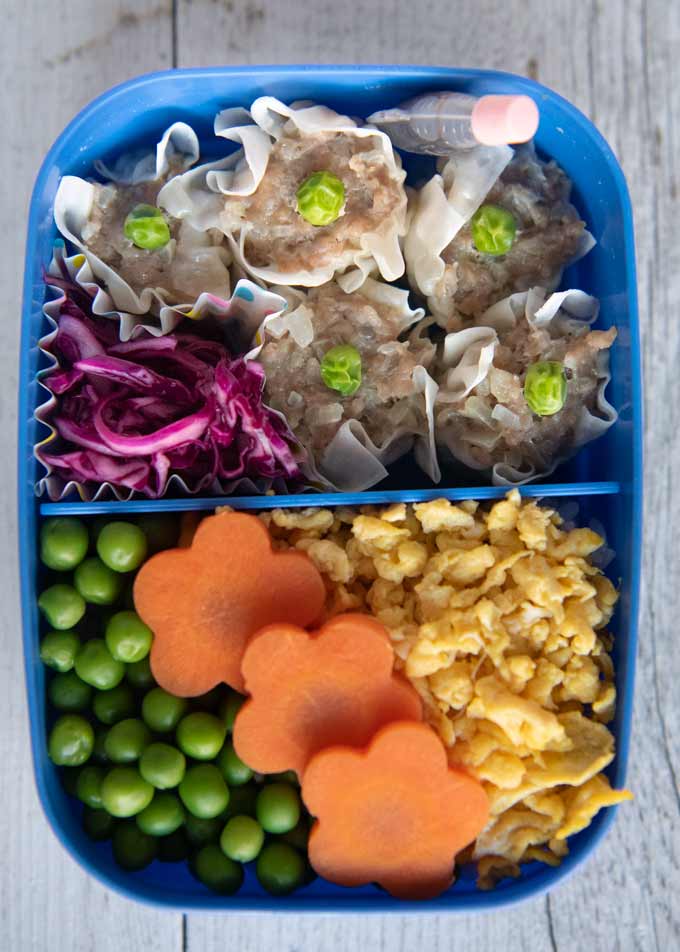
One of my readers requested for a bento that is suitable for a school lunch. A simple bento that her child could also help to make. I thought of Shumai Bento straight away because Shumai (or Shao Mai, Steamed Dumpling) is something you and your child can make together.
I also thought of a colourful bento that both children and adults can be wowed by. Making a Shumai Bento is not difficult, and it is also fun to decorate the rice.
Ekiben and Shumai Bento
If you travel Japan by train, you will notice many food shops inside and outside the stations that sell all sorts of bento in disposable containers. They are called ‘ekiben’ (駅弁), which is a shortened form of ‘eki bento’ (駅弁当), meaning station bento. Some ekiben are not cheap but gorgeous look like the one below and you get to taste so many dishes in one bento box.
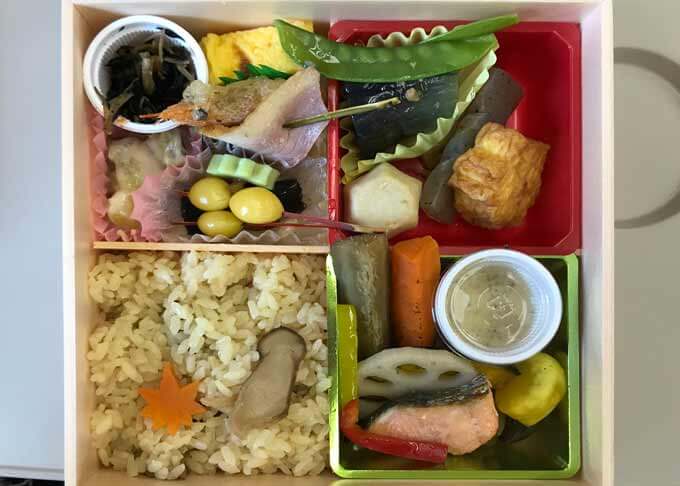
I bought this ekiben at Tokyo station and ate it in the carriage of the Hokuriku Shinkansen.
Many of the bento are everyday bento like those in my Bento Collection and they are sold at train stations all over Japan. But many stations sell their local specialty bento. Ekiben companies work hard to make delicious bento utilising their local produces. There is even an annual event called Ekiben Fair, where you can see and buy all kind of sepcialty ekiben in one place!
Shumai Bento is a representative bento of Yokohama station in Kanagawa prefecture. Shumai is the main dish in the bento box, but there are quite a few side dishes packed in with the shumai.
This bento was introduced by a food and restaurant chain called Kiyōken (崎陽軒) in mid 1950s. It was created with the intention of making a famous food for Yokohama. The biggest China Town in Japan is located in Yokohama. So it was natural to pick Shumai, which came from China, and make it the representative food.
Kiyōken’s Shumai Bento is sold at stations, in the train and even at some shopping centres.
What’s in My Shumai Bento
My Shumai Bento does not resemble Yokohama bento at all but shumai is the star of today’s bento just as it is in the Yokohama’s bento.
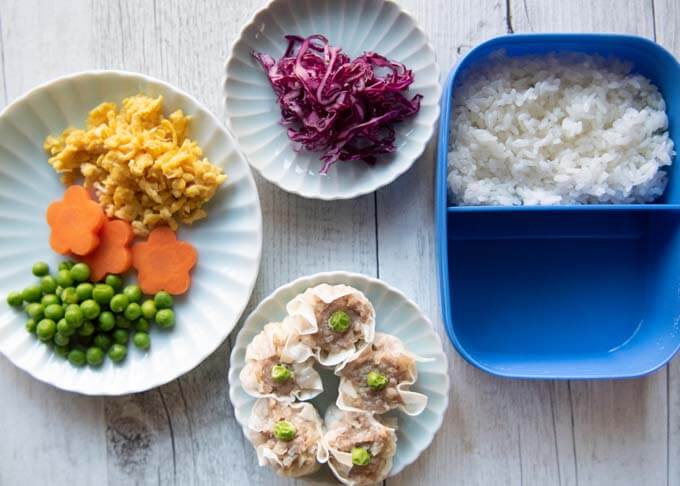
- Cooked rice– this can be made ahead. Please refer to How to Cook Rice the Japanese Way. Pack the cooked rice in a bento box while the rice is still hot or warm as it is easier to shape it, and let it cool down before adding other ingredients.
- Shumai – they can be made ahead and you can even freeze them. If frozen, reheat them in the microwave or a steamer before packing.
- Sweet and Sour Pickled Red Cabbage– make ahead. Instead of Pickled Red Cabbage, you can pack other pickled vegetables such as Pickled Chrysanthemum Radish.
- Iri Tamago – this is one of the three toppings from the recipe Sanshoku Bento (Tri-coloured Rice Bowl).
- Peas – this is also one of the three toppings from the recipe Sanshoku Bento (Tri-coloured Rice Bowl).
- Flower-shaped Carrots – I used the same carrot in Sanshoku Bento as well. But in this bento box, I used 3 slices.
- Soy Sauce – the sauce is to be poured over the Shumai. It is much better to put the soy sauce in a small container if you can and pour it over just before eating.
Packing Shumai Bento

Since some dishes go on top of the rice, I partitioned the bento box into two almost equal areas – one area to put the rice with toppings, one area for Shumai. If your bento box comes with a divider, that would make things easier. But if not, just make a wall with the rice to partition.
- Fill about half of the bento box with the rice, allowing for a 1cm / ⅜” margin at the top, then place the Shumai pieces in the space next to the rice.
- Put Pickled Red Cabbage in an okazu cup and place it next to the Shumai.
- Cover half of the rice with Iri Tamago, the rest with Peas.
- Place Flower-shaped Carrots along the dividing line of the rice toppings.
I used an okazu cup for the Pickled Red Cabbage because it comes with a small amount of pickling liquid. I did not want to get the Shumai soaked in the sour liquid.
I drew the partition of two ingredients on the rice diagonally but it is up to you. The placement of carrots can also be re-arranged.
Note: It is a common practice to eat Shumai with soy sauce and mustard. But I did not include mustard in this bento because I was thinking of a bento box for a school kid. If you would like to add mustard, I would either put it in the corner of the bento box next to Shumai or put a small amount of mustard on top of each Shumai.
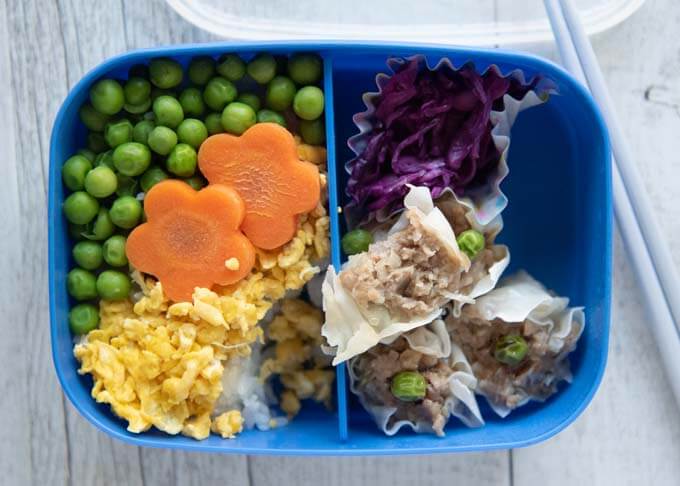
Yumiko![]()
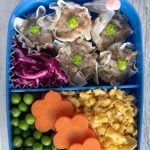
The main dish of today’s bento is Shumai but my Shumai Bento is a colourful bento - the rice is covered with Japanese scrambled eggs and green peas, and decorated with the flower-shaped carrots. The pickled red cabbage adds an extra colour to the already colourful bento!
Because bento is usually made mostly from left-over dishes or make-ahead dishes, the time indicated in this recipe only shows the time to pack the bento box.
- 1 cup cooked rice (note 1)
- 5 pieces Shumai (note 2)
- ½ portion Iri Tamago from Sanshoku Bento recipe
- ½ portion Peas from Sanshoku Bento recipe
- 3 round slices of carrot cut into flower shape (3mm (⅛") thickness, Note 3)
- 2 tbsp Sweet and Sour Pickled Red Cabbage
- 1 okazu cup
-
Fill about half of the bento box with the rice, allowing for 1cm / ⅜” margin at the top (see the first photo in this post).
-
Place Shumai pieces next to the rice, filling most of the remaining space of the bento box.
-
Put Pickled Red Cabbage in the okazu cup and place it next to the shumai.
-
Cover half of the rice with Iri Tamago and the rest with Peas.
-
Place the flower-shaped carrots over the line between the egg and the peas.
1. It is best to pack the cooked rice in a bento box while hot or warm as it is easier to shape the rice into the bento box.
2. Shumai can be made ahead and you can even freeze them. If frozen, reheat them in the microwave or a steamer before packing.
If your bento box is larger or the amount of rice you filled the bento box with is smaller, you may increase the number of Shumai pieces.
3. If you have a vegetable cutter in a flower shape (see the post Sanshoku Bento for samples), that would be the easiest. But if you don't, you can still make a flower carrot with a knife.
To make a plum flower shape with a knife: Slice one round slice (3mm / ⅛" thickness) taken from the length of the carrot. Make 5 small v-shaped cuts around the edge of the round slice in equal spacing. Shape the edges of the petals by removing pointy edges.
Boil or microwave the flowers to soften them.
Thank you so much for this recipe. We are very excited to make this for school lunch. Looks delicious.
Hi Lou, that’ll be lovely and your kids would be so proud of you!